Bioversity, Borlaug Institute for South Asia and CIMMYT work more closely on climate resilient farming in eastern India
By M.L. Jat/CIMMYT
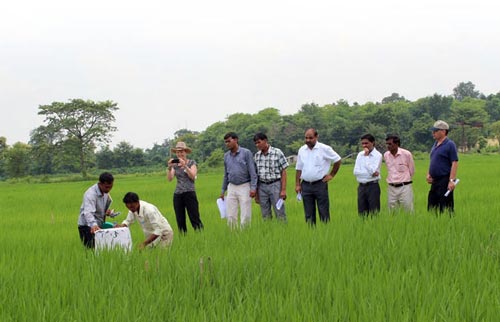
Increased access to seeds better suited for local conditions and climate-smart crop management technologies are two strategies Bioversity International and CIMMYT India are using to improve the climate change resilience of resource-poor farmers. With the 14 August visit of Bioversity International Director General Ann Tutwiler to the Borlaug Institute for South Asia (BISA) Pusa site and the climate-smart villages in the Vaishali district of Bihar, this partnership has strengthened and will work to improve farmers’ coping and adaptation to climate change in eastern India. The groups are working under Climate Change, Agriculture and Food Security (CCAFS).
Agriculture is affected by variable temperatures and erratic climate events. Smallholder farmers who are impacted suffer from low production and increasing costs. Tutwiler said that CIMMYT, BISA and Bioversity have common interests and should complement each other’s work in making smallholder farmers climatesmart through local adaptation of stress-tolerant seeds and integrating them with better agronomic management. The greatest need is in multi-stakeholder partnerships and to apply collective wisdom to address these challenges for farmers’ benefits, she said.
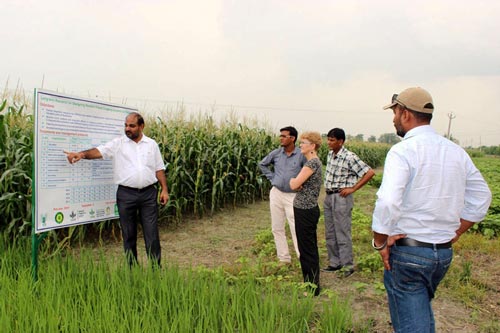
Tutwiler and other visitors saw strategic research on conservation agriculture at the BISA farm as well as collaborative research between CIMMYT and the Indian Agricultural Research Institute (IARI). Participants discussed the long-term benefits of conservation agriculture, such as increased productivity, improved soil fertility, cost savings and reduction of greenhouse gas emissions. “At Pusa, we have established long-term research on conservation agriculture in predominant cropping systems to monitor and devise resilient future cropping systems and their component technologies for the eastern Indo Gangetic Plains,” said M.L. Jat, a CIMMYT senior cropping systems agronomist. “These work as capacity-building platforms for various stakeholders.”
The team also saw climate-smart technologies promoted by CIMMYT in collaboration with other CGIAR centers and national agricultural research and extension services under CCAFS. Mamta Kumari, a woman farmer from the climate-smart village Rajapakar said, “Rainfall has been unreliable for the last few years. Our crops and livelihoods are at risk with changing weather. But we are now getting more information about new seed, methods and technologies; we can see a change.” With access to timely information on weather, better-adapted seeds and improved crop management, women farmers are now feeling more empowered. “We are saving around 5,000 Rupees (about US$79) on the cost of production using zero tillage in wheat cultivation,” Kumari said. Tutwiler met and shared her experiences with CIMMYT Director General Thomas Lumpkin and discussed common goals of Bioversity, BISA and CIMMYT to improve lives of farmers under changing climate conditions
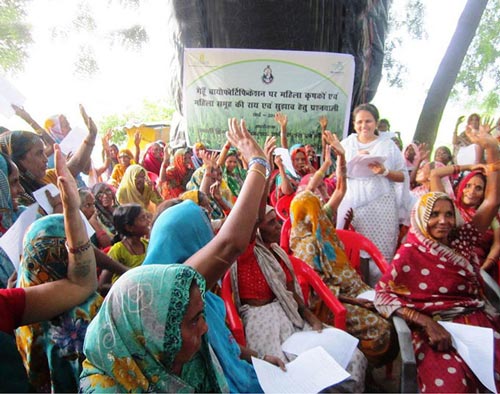
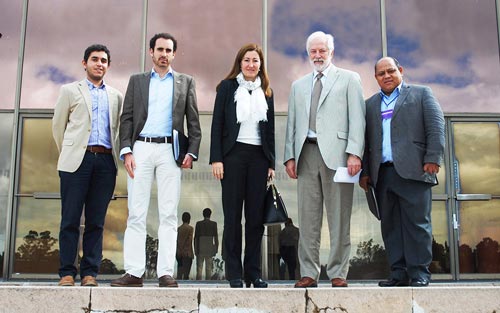
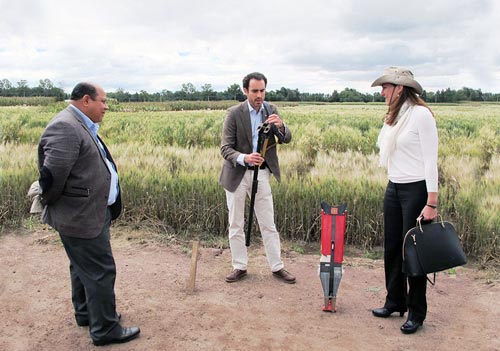
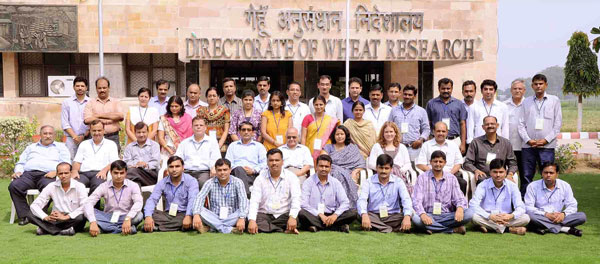 The training was for young scientists from different wheat research stations of India involved in a BMZ-funded project to increase the productivity of wheat under rising temperatures and water scarcity in South Asia. The training program attendees’ enhanced understanding of existing molecular tools for wheat breeding as well as emerging tools such as genomic selection. “Molecular tools will play an increasing role in wheat breeding to meet challenges in coming decades,” said Indu Sharma, director of DWR in Karnal. The program covered both theory and practice on the use of molecular makers in wheat breeding, especially those related to vernalization, photoperiodism and earliness per se, which could be used to enhance early heat tolerance. Practical sessions in the molecular laboratory of DWR focused on extraction of DNA, quantification and quality control of DNA, polymerase chain reaction polymerase chain reaction amplification and electrophoresis.
The training was for young scientists from different wheat research stations of India involved in a BMZ-funded project to increase the productivity of wheat under rising temperatures and water scarcity in South Asia. The training program attendees’ enhanced understanding of existing molecular tools for wheat breeding as well as emerging tools such as genomic selection. “Molecular tools will play an increasing role in wheat breeding to meet challenges in coming decades,” said Indu Sharma, director of DWR in Karnal. The program covered both theory and practice on the use of molecular makers in wheat breeding, especially those related to vernalization, photoperiodism and earliness per se, which could be used to enhance early heat tolerance. Practical sessions in the molecular laboratory of DWR focused on extraction of DNA, quantification and quality control of DNA, polymerase chain reaction polymerase chain reaction amplification and electrophoresis.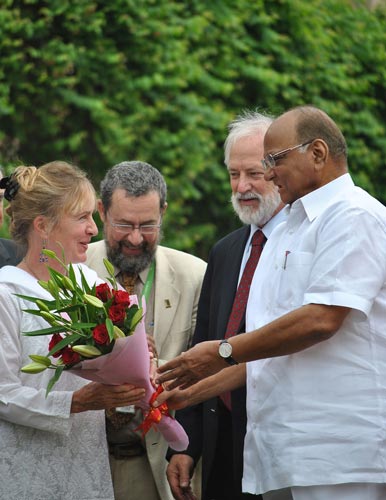
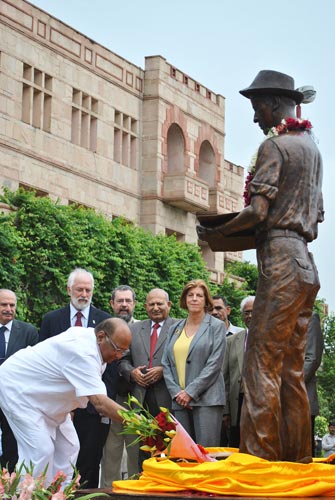
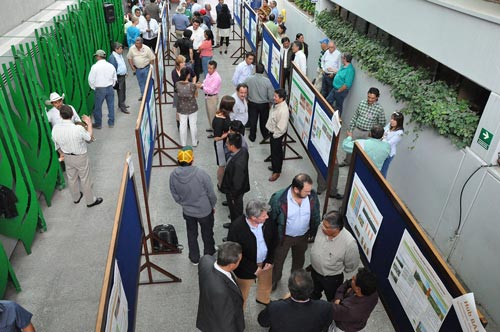 Husband-and-wife duo Oscar Hernández Mendoza and Rosa Elena Montiel Díaz said their work with MasAgro helps them improve the lives of farmers in their town. The two made a presentation about their efforts in Úrsulo Galván, Veracruz, on 29 August during CIMMYT’s first symposium for MasAgro experimental platforms. MasAgro, or the Sustainable Modernization of Traditional Agriculture, is a CIMMYT program coordinated with Mexico’s Ministry of Agriculture, Livestock, Rural Development, Fisheries, and Food (SAGARPA).
Husband-and-wife duo Oscar Hernández Mendoza and Rosa Elena Montiel Díaz said their work with MasAgro helps them improve the lives of farmers in their town. The two made a presentation about their efforts in Úrsulo Galván, Veracruz, on 29 August during CIMMYT’s first symposium for MasAgro experimental platforms. MasAgro, or the Sustainable Modernization of Traditional Agriculture, is a CIMMYT program coordinated with Mexico’s Ministry of Agriculture, Livestock, Rural Development, Fisheries, and Food (SAGARPA).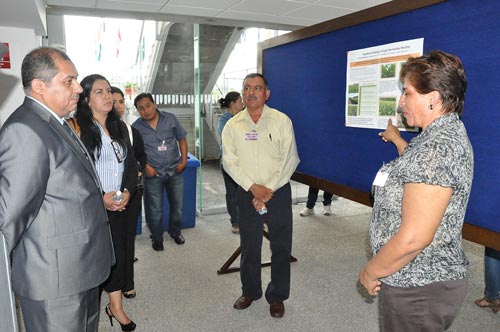 Jesús Rafael Valenzuela Borbón came to the symposium from Navojoa, in southern Sonora. He is trying to bring conservation agriculture practices to farmers in an area where the main problem is a lack of water. Valenzuela is in charge of an experimental site where he is growing maize and wheat using crop rotation. Use of such practices in the area is minimal, though Valenzuela is looking for support to implement them more widely, he explained. “All of the results are very favorable,” he said.
Jesús Rafael Valenzuela Borbón came to the symposium from Navojoa, in southern Sonora. He is trying to bring conservation agriculture practices to farmers in an area where the main problem is a lack of water. Valenzuela is in charge of an experimental site where he is growing maize and wheat using crop rotation. Use of such practices in the area is minimal, though Valenzuela is looking for support to implement them more widely, he explained. “All of the results are very favorable,” he said.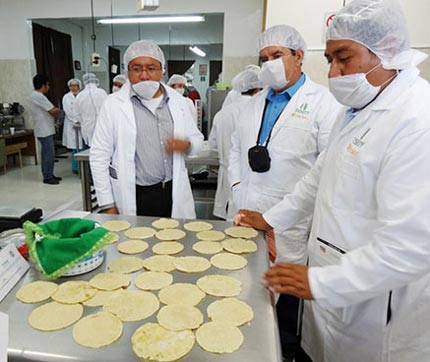 Mexico is the fifth highest maize-consuming country in the world. It is also the number one consumer of maize for food, given that its population eats 70 percent of available maize grain every year. The national food maize groups included in this percentage can be divided into three main types: home consumption, the nixtamalized flour industry and the maize dough and tortilla industry. Businesses in the latter sector must supply maize grain of uniform quality so that maize processing will be more efficient, stable and profitable. With this in mind, 30 Mexican dough and tortilla manufacturers, grain marketers and seed producers attended a practical training course entitled “Maize Grain Quality and Technology” given by researchers from the Sustainable Modernization of Traditional Agriculture (
Mexico is the fifth highest maize-consuming country in the world. It is also the number one consumer of maize for food, given that its population eats 70 percent of available maize grain every year. The national food maize groups included in this percentage can be divided into three main types: home consumption, the nixtamalized flour industry and the maize dough and tortilla industry. Businesses in the latter sector must supply maize grain of uniform quality so that maize processing will be more efficient, stable and profitable. With this in mind, 30 Mexican dough and tortilla manufacturers, grain marketers and seed producers attended a practical training course entitled “Maize Grain Quality and Technology” given by researchers from the Sustainable Modernization of Traditional Agriculture (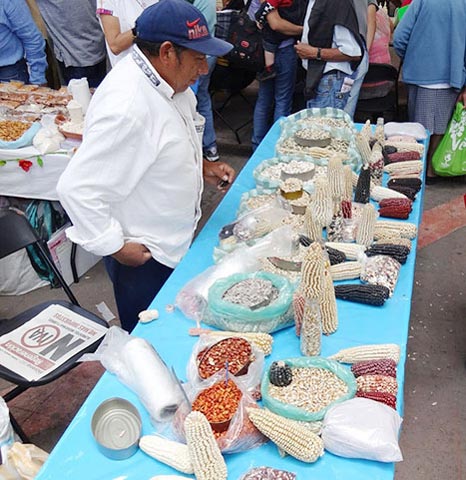 After exchanging their experiences, businessmen, grain merchants and seed producers showed interest in revising Mexican Regulation (Norma Mexicana) 034-1 on grain quality to make the range of values match the current dough- and tortilla-making process. In their opinion, the different links of the maize production chain are increasingly demanding when it comes to the raw materials, processes and products they use. For this reason, Gricelda Vázquez of INIFAP’s Valley of Mexico Experiment Station (CEVAMEX) thinks continued collaboration among research and industrial institutions is needed to ensure that research results extend beyond the production process. As David Tecotl pointed out, “Only by attending these courses at the university do we acquire firsthand knowledge of these important alternatives.” He and his fellow trainees tested the best techniques for mixing nixtamalized flour (of bean, barley, oat, amaranth, and maize) to make more nutritionally rich tortillas, as did the UACh students who are doing their Ph.D. research under the supervision of Ofelia Buendía, one of the course organizers.
After exchanging their experiences, businessmen, grain merchants and seed producers showed interest in revising Mexican Regulation (Norma Mexicana) 034-1 on grain quality to make the range of values match the current dough- and tortilla-making process. In their opinion, the different links of the maize production chain are increasingly demanding when it comes to the raw materials, processes and products they use. For this reason, Gricelda Vázquez of INIFAP’s Valley of Mexico Experiment Station (CEVAMEX) thinks continued collaboration among research and industrial institutions is needed to ensure that research results extend beyond the production process. As David Tecotl pointed out, “Only by attending these courses at the university do we acquire firsthand knowledge of these important alternatives.” He and his fellow trainees tested the best techniques for mixing nixtamalized flour (of bean, barley, oat, amaranth, and maize) to make more nutritionally rich tortillas, as did the UACh students who are doing their Ph.D. research under the supervision of Ofelia Buendía, one of the course organizers.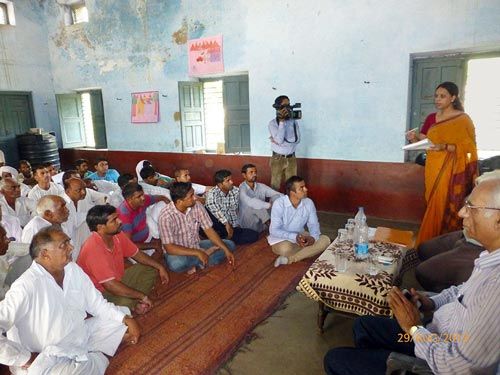
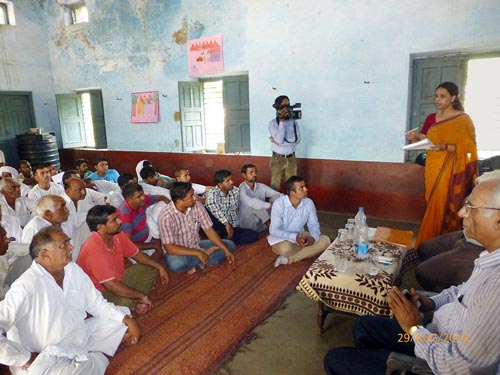
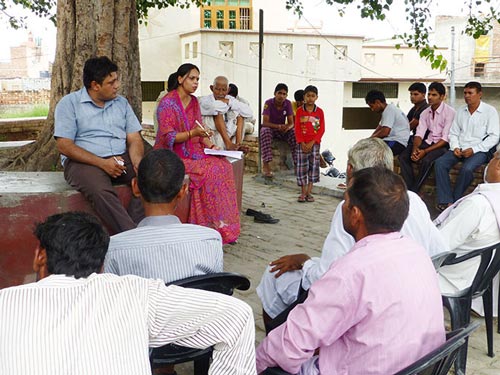
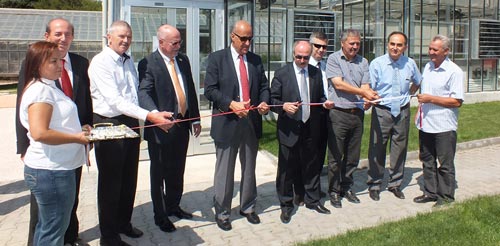

 Introducing maize stover into India’s commercial dairy systems could mitigate fodder shortages and halt increasing fodder costs, according to new research by CIMMYT and the
Introducing maize stover into India’s commercial dairy systems could mitigate fodder shortages and halt increasing fodder costs, according to new research by CIMMYT and the  This dairy producer had maintained his eight improved Murrah buffaloes on a diet typical of that of urban and near-urban dairy systems in peninsular India. It consisted of 60% sorghum stover and 40% a homemade concentrate mix of 15% wheat bran, 54% cotton seed cake, and 31% husks and hulls from threshed pigeon-pea. Each of the dairy producer’s buffaloes consumed about 9.5 kg of sorghum stover and 6.5 kg of the concentrate mix per day and produced an average of 8.9 kg of milk per day. This dairy producer purchased sorghum stover at 6.3 Indian rupees (Rs) per kilogram. Together with the cost for concentrates, his feed cost totalled 18.2 Rs per kg of milk while his sale price was 28 Rs per kg of milk. In this trial, the dairy farmer purchased maize stover at 3.8 Rs per kg. When he substituted sorghum stover with maize stover, his average yield increased from 8.9 to 9.4 kg of milk per buffalo per day while his overall feed costs decreased from 18.2 to 14.5 Rs per kg of milk per day. The substitution of sorghum stover with maize increased his profits from 3.7 Rs per kg of milk, apart from an additional 0.5kg milk per buffalo.
This dairy producer had maintained his eight improved Murrah buffaloes on a diet typical of that of urban and near-urban dairy systems in peninsular India. It consisted of 60% sorghum stover and 40% a homemade concentrate mix of 15% wheat bran, 54% cotton seed cake, and 31% husks and hulls from threshed pigeon-pea. Each of the dairy producer’s buffaloes consumed about 9.5 kg of sorghum stover and 6.5 kg of the concentrate mix per day and produced an average of 8.9 kg of milk per day. This dairy producer purchased sorghum stover at 6.3 Indian rupees (Rs) per kilogram. Together with the cost for concentrates, his feed cost totalled 18.2 Rs per kg of milk while his sale price was 28 Rs per kg of milk. In this trial, the dairy farmer purchased maize stover at 3.8 Rs per kg. When he substituted sorghum stover with maize stover, his average yield increased from 8.9 to 9.4 kg of milk per buffalo per day while his overall feed costs decreased from 18.2 to 14.5 Rs per kg of milk per day. The substitution of sorghum stover with maize increased his profits from 3.7 Rs per kg of milk, apart from an additional 0.5kg milk per buffalo.

